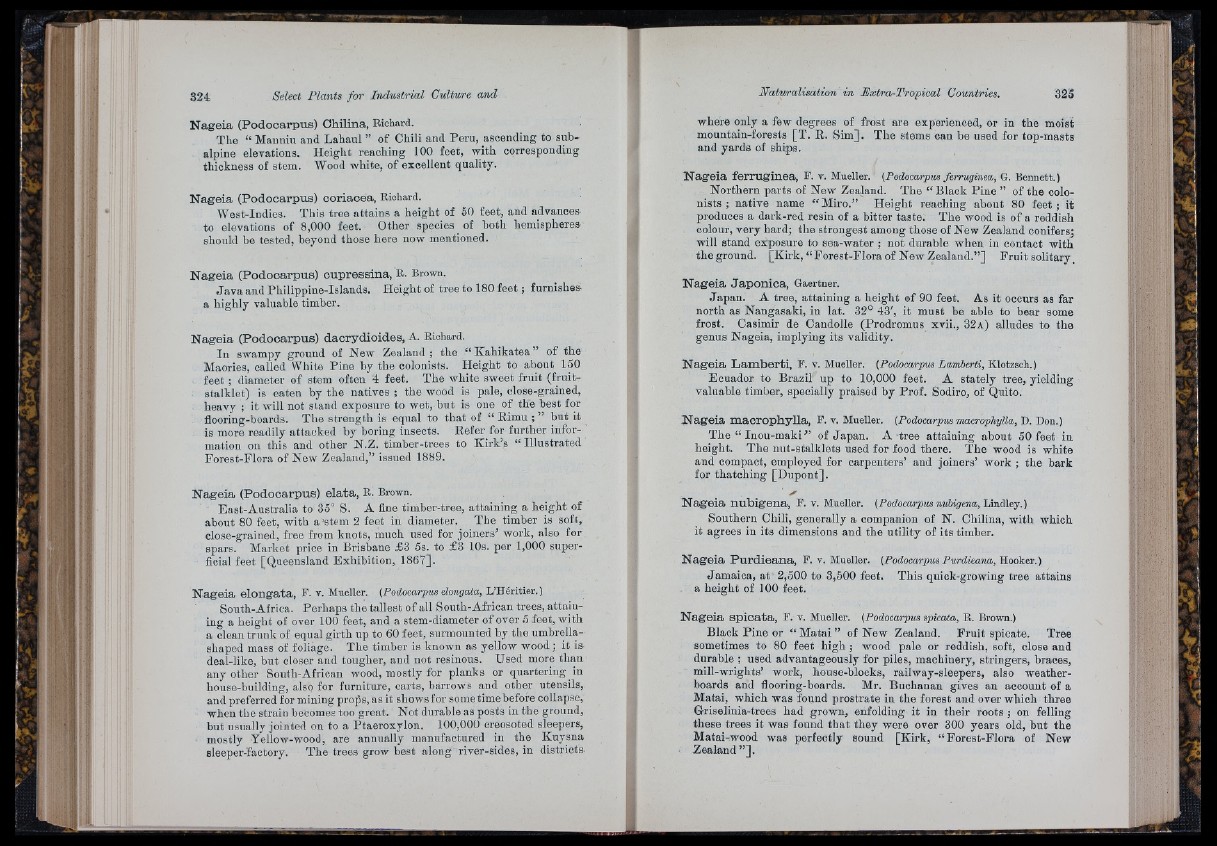
I í i
Nageia (Podocarpus) Chilina, Richard.
The “ Manniu and Lahaul ” of Chili and Peru, ascending to sub-
alpine elevations. Height reaching 100 feet, with corresponding
thickness of stem. Wood white, of excellent quality.
Nageia (Podocarpus) coriacea, Richard.
West-Indies. This tree attains a height of 60 feet, and advances
to elevations of 8,000 feet. Cther species of both hemispheres
should be tested, beyond those here now mentioned.
Nageia (Podocarpus) cupressina, R. Brown.
J a v a and Philippine-Islands. Height of tree to 180 f e e t; furnishes
a highly valuable timber.
Nageia (Podocarpus) dacrydioides, A. Richard.
In swampy ground of New Zealand; the “ K ahikate a” of the
Maories, called White Pine by the colonists. Height to about 150
f e e t ; diameter of stem often 4 feet. The white sweet fruit (fruit-
stalklet) is eaten by the natives ; the wood is pale, close-grained,
heavy ; it will not stand exposure to wet, but is one of the best for
flooring-boards. The strength is equal to th a t of “ Rimu ; ” but it
is more readily attacked by boring insects. Refer for further information
on this and other N.Z. timber-trees to Kirk’s “ Illustrated
Forest-Flora of New Zealand,” issued 1889.
Nageia (Podocarpus) elata, R. Brown.
East-Australia to 35° S. A fine timber-tree, attaining a height of
about 80 feet, witb a'stem 2 feet in diameter. The timber is soft,
close-grained, free from knots, much used for joiners’ work, also for
spars. Market price in Brisbane £ S 5s. to £3 10s. per 1,000 superficial
feet [Queensland Exhibition, 1867].
Nageia elougata, F. V. Mueller. (Podocarpus elmgata, L’Héritier.)
South-Africa. Perhaps the tallest of all South-African trees, attaining
a height of over 100 feet, and a stem-diameter of over 5 feet, w ith
a clean trunk of equal girth up to 60 feet, surmounted by the umbrellashaped
mass of foliage. The timber is known as yellow wood; it is
deal-like, but closer and tougher, and not resinous. Used more than
any other South-African wood, mostly for planks or quartering in
house-building, also for furniture, carts, barrows and other utensils,
and preferred for mining projJs, as it showsfor some time before collapse,
when the strain becomes too great. Not durable as posts in the ground,
hut usually jointed on to a Ptaeroxylon. 100,000 creosoted sleepers,
mostly Yellow-wood, are annually manufactured in the Kuysna
sleeper-factory. The trees grow best along river-sides, in districts
where only a few degrees of frost are experienced, or in the moist
mountain-forests [T. R. Sim ]. The stems can be used for top-masts
and yards of ships.
N a g e ia fe rru g in e a , F. v. Mueller. (Podocarpus ferruginea, G. Bennett.)
Northern parts of New Zealand. The “ Black Pine ” o fth e colonists
; native name “ Miro.” Height reaching about 80 feet ; it
produces a dark-red resin of a bitter taste. The wood is of a reddish
colour, very hard; the strongest among those of New Zealand conifers;
will stand exposure to sea-water ; not durable when in contact with
the ground. [Kirk, “ Forest-Flora of New Zealand.”] F ru it solitary.
N a g e ia J a p ó n ic a , Gaertner.
Japan. A tree, attaining a height of 90 feet. As it occurs as far
north as Nangasaki, in lat. 32° 43', it must be able to bear some
frost. Casimir de Candolle (Prodromns xvii., 32a ) alludes to the
genus Nageia, implying its validity.
N a g e ia L am b e r ti, F. v. Mueller. (Podocarpus Lamberti, Klotzsch.)
Ecuador to Brazil up to 10,000 feet. A stately tree, yielding
valuable timber, specially praised by Prof. Sodiro, of Quito.
N a g e ia m a c ro p h y lla , F. v. Mueller. (Podocarpus macrophylla, D. Don.)
The “ Inou-maki ” of Japan. A -tre e attaining about 50 feet in
height. The nut-stalklets used for food there. The wood is white
and compact, employed for carpenters’ and joiners’ work ; the bark
for thatching [Dupont].
✓
N a g e ia n u b ig e n a , F. v. Mueller. (Podocarpus nubigenaflAailoy.)
Southern Chili, generally a companion of N. Chilina, with which
it agrees iu its dimensions aud the utility of its timber.
N a g e ia P u rd ie a n a , F, v. Mueller. (Podocarpus Purdieana,'S.oakw.)
Jamaica, a t 2,500 to 3,500 feet. This quick-growing tree attains
a height of 100 feet.
N a g e ia s p ic a ta , F. v. Mueller. (Podocarpus spicata, R. Brown.)
Black Pine or “ M atai ” of New Zealand. F ru it spioate. Tree
sometimes to 80 feet high ; wood pale or reddish, soft, close and
durable ; used advantageously for piles, machinery, stringers, braces,
mill-wrights’ work, house-blooks, railway-sleepers, also weatherboards
and fiooring-boards. Mr. Buchanan gives an account of a
Matai, which was found prostrate in the forest and over which three
Griselinia-trees had grown, enfolding it in their roots ; on felling
these trees it was found that they were over 300 years old, but the
Matai-wood was perfectly sound [Kirk, “ Forest-Flora of New
Ze a lan d ” ].
'S:
'fife
gif 7